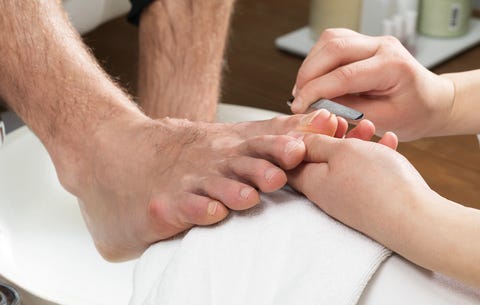How to Get Rid of a Hang Toenail
The excruciating pain of an ingrown toenail is unlike any other: The sharp, stabbing pain with every step you take can be unbearable, to the point that simply shuffling down the hall can feel impossible.
If you have an ingrown toenail, the side border of your toenail — usually your big toe —starts to dig in and irritate the skin, explains Christopher R. Hood Jr., D.P.M., of Premier Orthopedics and Sports Medicine in Pottstown, Pennsylvania.
"The sharp edge digging into the skin may set a pathway of irritation to inflammation (warmth, redness, swelling) to infection (drainage, pus), all of which cause pain," he says.
Plus, ingrown toenails hurt so damn bad because the skin near your nail corners is a particularly sensitive area, since it's rich with nerves, says Jeffrey D. Lehrman, D.P.M., of Crozer-Keystone Health System.
But how do they happen in the first place, and how can you get rid of them? We've got the answers.
What causes ingrown toenails?

Getty Images
There's no straight answer for what causes ingrown toenails. But it could be anything from your attire to your workout to your grooming habits. Tight-fitting shoes, for instance, can heighten your risk of getting a ingrown toenail. If your shoes fit too tight around the toes, it puts more pressure on the front of your foot, pushing your toes into the end, says Dr. Hood.
Ingrown toenails are also common among runners. "Any activity with repetitive pressure of the nail in the shoe, such as running, biking, or other sports, can put you at risk for an ingrown nail," says Ellie Nasser, D.P.M., a podiatry associate in the department of orthopedics at Geisinger Health System. Pressure on the nail encourages the nail to grow beneath the skin, which causes irritation and swelling.
Clipping your nails too short or cutting them at an angle can also impact the way the nail grows, encouraging them to grow into the skin rather than straight out, says Dr. Hood. Make sure that you're following the proper way to cut your toenails (yes, there is one): Cut straight across, making sure you're not doing so at an angle or digging in to the corners. You should also keep your toenails long — say, one to two millimeters at the end of the nail — so they're not at risk of growing inward, but short enough so debris can't gather underneath them, says Dr. Hood.
How to get rid of ingrown toenails

Getty Images
If you already have an ingrown toenail, don't freak out: chances are good that you can treat it at home without resorting to any outside intervention. "In the early stages of an ingrown nail, lukewarm epsom salt soaks may help to break up any debris building up beneath the nail and reduce inflammation," says Dr. Nasser. If you soak your feet for 20 minutes, the lukewarm water will encourage the nail to grow outward; it'll also get rid of debris, which will help to prevent buildup and possible infection.
Afterwards, don't forget to apply an ointment. Over-the-counter topical meds like a triple antibiotic ointment can help induce infection risk, and ointments containing salicylic acid
"Don't play bathroom surgeon."
If the issue doesn't get better over the next few days, you need to consult a podiatrist. "Don't play bathroom surgeon," says Dr. Hood. If just the corner at the end of your nail is digging into your skin, your doctor may perform something called the slant-back procedure, in which the corner of the nail is cut out to allow the nail to stop growing into the skin.
But if you have a fully ingrown nail along with signs of infection, such as thick, yellow, or milky-colored pus, your doctor may perform a partial nail avulsion to get rid of that bad boy. "This entails locally numbing the digit and using sterile instruments, freeing up the entire border from the skin and cutting it out," says Dr. Hood. (In case you want to absolutely ruin your day, here is an absolutely NSFW GIF of an ingrown toenail being removed, which you should watch at your own risk.)
If you tend to get recurrences of ingrown toenails, your doctor will place a medicine, usually an acid, under the skin at the base of the nail, which destroys the nail matrix where your nail is growing from, says Dr. Hood.
"I relate this to placing a 'weed killer' to the root of the nail so it does not grow back, which is typically high effective," he says.
Emily Shiffer Emily Shiffer is a former digital web producer for Men's Health and Prevention, and is currently a freelancer writer specializing in health, weight loss, and fitness.
This content is created and maintained by a third party, and imported onto this page to help users provide their email addresses. You may be able to find more information about this and similar content at piano.io
How to Get Rid of a Hang Toenail
Source: https://www.menshealth.com/health/a18736410/how-to-get-rid-of-an-ingrown-toenail/
0 Response to "How to Get Rid of a Hang Toenail"
Post a Comment